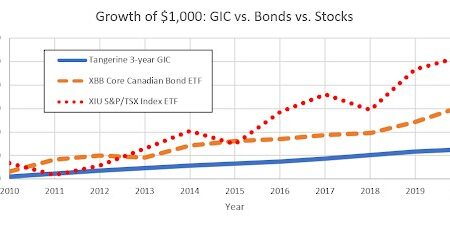Smith Manoeuvre Portfolio June 2009 – The Rally Continues!
For those of you just joining us, this is my portfolio that is leveraged with money borrowed from my home equity line of credit (HELOC). As the money borrowed is used to invest, the interest charged is tax deductible. I write an update every couple months or so to show new positions added along with any market gains/losses. For more details, check out my modified smith manoeuvre strategy.
In the last update, I expected a pull back soon after the post, however, that hasn’t materialized yet. I still expect some sort of correction at which time I will be deploying more capital. Even without the pullback, there were some equities that were selling near their 52 week lows, like utilities. Having said that, I initiated a position with Canadian Utilities (CU), TransAlta (TA) in addition to adding to my Fortis (FTS) position. Not only did I buy a few utilities, I initiated my position in Enbridge (ENB) and First Capital Realty (FCR) – a REIT dressed as a corporation.
I usually don’t sell within this portfolio as I would like to keep the dividend stream going for as long as possible. However, there are times when companies change or get bought out. In this case, I sold off my position in Petro Canada (PCA). The reason being is that Suncor is in the process of merging with Petro Canada which will most likely result in a reduced dividend. In addition, I already own Suncor within my RRSP.
The Portfolio as of June 2009:
| Stock | Symbol | Shares | Avg Buy Price | Total | Div/Share | Yield |
| Royal Bank | RY.T | 75 | $47.62 | $3,571.25 | $2 | 4.20% |
| CIBC | CM.T | 45 | $67.14 | $3,021.25 | $3.48 | 5.18% |
| Power Financial | PWF.T | 105 | $35.14 | $3,689.65 | $1.40 | 3.98% |
| Scotia Bank | BNS.T | 105 | $41.91 | $4,400.52 | $1.96 | 4.68% |
| Manulife Financial | MFC.T | 125 | $33.12 | $4,139.48 | $1.04 | 3.14% |
| Fortis Properties | FTS.T | 150 | $25.63 | $3,843.98 | $1.04 | 4.06% |
| TransCanada Corp | TRP.T | 100 | $33.50 | $3,349.74 | $1.52 | 4.52% |
| FTSE RAFI US 1500 Small-Mid ETF | PRFZ.US | 20 | $51.50 | $1,029.99 | $0.42 | 0.82% |
| AGF Management Limited | AGF.B.T | 50 | $22.71 | $1,135.49 | $1.00 | 4.40% |
| Bank of Montreal | BMO.T | 25 | $44.17 | $1,104.24 | $2.80 | 6.34% |
| Husky Energy | HSE.T | 85 | $35.90 | $3,051.28 | $1.20 | 3.34% |
| Teck Cominco | TCK.B.T | 100 | $15.35 | $1,258.99 | $0.00 | 0.00% |
| TD Bank | TD.T | 50 | $48.24 | $2,412.23 | $2.44 | 5.06% |
| Enbridge | ENB.T | 40 | $37.36 | $1494.39 | $1.48 | 3.96% |
| TransAlta | TA.T | 50 | $21.47 | $1073.49 | $1.16 | 5.40% |
| First Capital Realty | FCR.T | 100 | $15.75 | $1,574.99 | $1.28 | 8.13% |
| Canadian Utilities | CU.T | 50 | $36.40 | $1,819.99 | $1.41 | 3.87% |
More Stats
- Total Portfolio Book Value: $52,235 (total invested from HELOC including after tax interest)
- Portfolio Value (Cash + Equities): $49,196.60
- Total Cost Base of Equities (inc. fees): $41,970.95
- Market Value of Equities (June 16, 2009): $39,125
- Total Dividends / Year: $1,765.50
- Portfolio Dividend Yield: 4.21%
Sector Allocation (based on market value)
- Financials: 51.79%
- Utilities: 16.79%
- Energy: 20.00%
- Resources: 4.96%
- Real Estate: 4.52%
- Other: 1.95%
Leveraged Investing Disclaimer: There have been a lot of readers who have mentioned that they are interested in a leveraged portfolio. Over the long term it may be lucrative. However, over the short term, equities are volatile and can put the portfolio deep in the red. My portfolio is a prime example of what can happen. If you can’t stomach losing 20-30% in the portfolio in any given year, then your risk tolerance isn’t suited for leveraged investing.










How have things gone with the taxman? I have a coworker that has been having a bit of a battle with CRA and it sounds like he has been doing things right. CRA insists it is a mortgage and not a line of credit and therefore isnt eligible. He has a homeline plan with RBC and bought through RBC to keep the paper straight forward and it is still an issue. I want to start the SM next year but I am now a little nervous.
Have you added anything else to this recently? I see Telus is almost at a 52 week low and has about a 6% yield right now. Seems like it could be a good time to buy, if you think they can maintain the dividend
Thank you. There are a few points there I did not consider there on income trusts.
What about the other questions, in particular #2?
Matt, to answer most of your questions, check out these posts about return of capital and leveraged investment accounts:
https://milliondollarjourney.com/use-smith-manoeuvre-tax-deductible-dividend-investing.htm
https://milliondollarjourney.com/tax-pay-stock-capital-gains.htm
https://milliondollarjourney.com/top-10-canadian-dividend-growth-stocks.htm
Note that CDZ has a portion of their distribution as return of capital.
In the ratio question above I left out price/book.
FT, a couple of questions:
1) Why no income trusts? There are a few paying some pretty good distributions with strong balance sheets. From what I can gather, income trusts are going to be treated in the same manner as corporations – so why the fuss? If they convert back to a corporation they will be treated like all other corporations and if they stay as a trust they will be taxed like a corporation. If the trust is paying out a dividend that is 50% higher than a corporation and taxes of 30-34% are introduced upon it, I’m pretty sure you still come out ahead of “normal” corporations in the end. Would someone else care to elaborate as I feel I might have over simplified this.
2) Increasing dividends each year, having a high yield, and being a part of CDZ are certainly major criteria for selecting a dividend stock. However is there any consideration given to consistent earnings growth, future prospects/growth, or the ratios: debt/equity ratio, price/sales, price/equity TTM, forward price/equity, price/sales, price/cash flow?
3) Do most users of this investing strategy follow dollar cost averaging or do you wait for a strike point? As an aside to make my question, anyone who got in on BMO at $25 with a 10% dividend in would be sitting pretty right now.
4) How do you determine the weighting of each stock in your portfolio? My rule of thumb is each stock gets an equal dollar amount, for example in starting up my portfolio, each stock gets $2000 (or whatever) and each new addition would get the same.
Sorry, looks like I had more than a few questions.
Hey CF! I’ve already sold my position in TCK.B within my SM portfolio but I’ve been seriously looking at it again since the news about the Chinese company purchasing a portion of it.
What other picks do you have your eye on for your leveraged portfolio?
FT,
A Desjardins analyst just upped his 12 month price target for TCK.B to above $29 from around $27. This was based on their deal with a Chinese company on Friday.
You may want to keep TCK.B just for capital appreciation.
I’m keeping it in my SM portfolio. As things improve, I would expect TCK.B to reinstitute a dividend perhaps in 2011.
Hi FT,
You’re right about Canadian banks being relatively safe. However, do you not think it is still risky to have so much there?
We define diversification as investing so that no one idea can either make us a killing or kill us. We would consider it very risky to borrow to invest in a global financial services fund, because of the narrow focus. Focusing on Canadian banks is a a subsector of financial services plus a tiny country focus. It is a universe of less than 1% of the universe for a global financial services fund.
In short, it is a subsector (banks) within a tiny region (Canada) within one sector (financials).
It is not hard to come up with a scenario where this would backfire. If Canada opened up banking to international competetition (which is likely at some point), the Canadian banks are horribly noncompetitive and would get massacred. Warren Buffett won’t even buy banks, because they have potential for undisclosed risks with off-balance sheet investments. And any sector will have ups and downs over the years.
The perception of them being the safest banks in the world also makes them the most expensive banks in the world.
I realize you like the nice dividends and that your RRSPs are invested differently, but do you not think that more diversification would be safer and have more growth potential, especially since this is leverage investments?
Ed
Ed, also note that when I say financials, that includes larger insurance holding like MFC and PWF, not just the banks. As well, if you look at the Canadian index, it’s over 30% financials.
But you are right, I am still heavy in financials. I’m looking to purchase some railways, retail, and a telecom when the valuations are attractive.
Blogging Banks, me too. :) In all seriousness though, Canadian banks are relatively conservative and right now, they are viewed as the “model” for banking around the world.